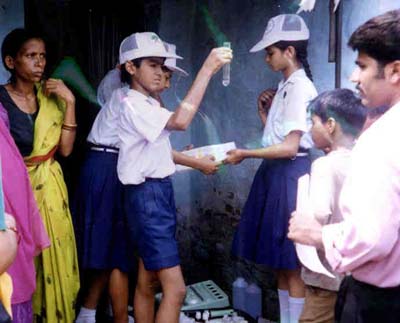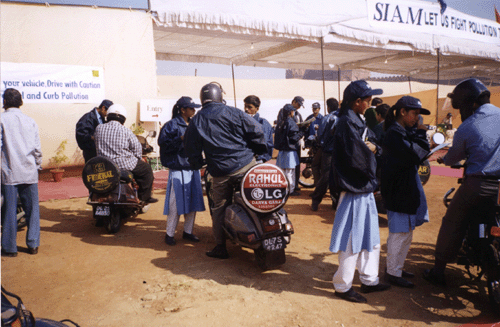| Water
- The Elixir of Life |
Klaus
Topfer, Executive Director UNEP, expressed in his World Water Day speech on 22nd
March, 1998 that:
|
"Water
is a powerful indicator of sustainability. It also is an indicator of the level
of social development in a particular community. It is an indicator of poverty
and social tensions. Water is also an issue that is linked with health,
nutrition and many other factors that affect our society including the condition
of nature itself! It is not an exaggeration to say that water is life."
|
 |
|
CLEAN
Brigade Testing Water Qulaity in Delhi Slums |
Water, besides air, is a vital ingredient for survival of all living beings. Out
of total availability of water on Earth, 97.2% occurs in oceans and seas, 2.2%
in ice caps and gl aciers and only 0.6 percent exists as fresh water, fit for
domestic consumption and irrigation. This amount may seem miniscule but, if used
in a sustainable way, is sufficient to meet all the requirements of our planet.
Human beings have still not learnt to live in harmony with nature. Instead, they
tend to be more and more destructive towards nature’s bounty and varied
biodiversity. This greed, to take more rather than give, has created an
imbalance in the natural resources and impacted the availability of water.
Wasteful utilization of water, its contamination due to industrial effluents,
its exploitation without recharging (leading to drying up of aquifers), soil
degradation and deforestation (resulting in run-offs), have culminated into a
crisis of insurmountable proportions. The effects of these unsustainable
tendencies are there for all to see in the form of floods and droughts, in an
intermittent cycle of calamities. The relentless march of the desert continues
unabated. Its impact is being felt more in developing and under developed
countries with large populations.
The Urban
Scenario
Statistics reveal that 50 percent
of the metropolitan cities in India are nothing but slums. These slums or
shantytowns have stemmed from the large-scale rural-urban migration in order to
survive, since the crop yield in rural India is not sufficient to provide
livelihoods for all. Hence the migration to city slums, which do not have even
the basic amenities essential for a decent living.
The maximum strain is upon the
water supply. The municipal corporations are stretched to the very limit and to
augment the supply, bore-wells are dug and hand-pumps installed for extracting
maximum ground water. Such measures have far-reaching adverse impacts on the
overall water situation such as the following:
| w |
Municipal supply is taxed to
the limit and there is no option but to restrict the supply timings to just two
hours a day. The situation worsens during summers when main water sources like
rivers, lakes, reservoirs, canals have reduced water levels in them. A fine
balancing act has to be done to cater to the needs of the urban supply as well
as irrigation needs. Sometimes the situation gets aggravated due to disputes
among riparian states on the quantum of water to be released for municipal
supply.
|
| w |
The mushrooming of bore-wells
and hand pumps has a negative impact on the water table. To provide housing to
the needy population, town planners have no option but to allow high rise
buildings as office complexes and residential flats. These buildings cannot do
without tube-wells to pump up water for the domestic needs of the occupants.
Even private bungalows have tube-wells to safeguard against the water-supply
crisis. Such activities have resulted in the water table going down by several
feet, with detrimental repercussions on the green cover and the environment.
|
| w |
Due to political compulsions,
the water supply authorities lay pipelines in slums and unauthorized colonies
without taking adequate precautions against contamination. A leaking pipeline
could be a major health hazard in such colonies with unhygienic conditions where
there is no proper arrangement for sewage, waste disposal and safe water supply.
Such areas are sources of large scale leaching, affecting the ground water and
culminating in gastroenteric epidemics.
|
| w |
Health services in cities and
towns are taxed to the limit. Water-borne diseases like cholera, hepatitis and
dysentery are highly contagious, and could prove to be extremely dangerous for
overpopulated slums. Due to the large population, the health services cannot
effectively monitor the health and sanitary conditions of the people and the
environment in which they reside. The residents of these congested colonies do
not have access to medical facilities, nor do they have enough finances to pay
for their treatment. The disease is either untreated, or self-medication is
practiced and as a last resort, some unauthorized/incompetent medical
practitioner is engaged. Such measures are responsible for a huge drain on the
health services.
|
The Rural
Scenario
 |
|
CLEAN
Students Interviewing Commuters Regarding the Air Quality in Delhi |
The water situation in the rural
sector is no better. Villages depend for their domestic requirements on wells,
tanks and ponds. All these sources rely on the monsoons for recharging the
ground water table. It is simple logic that if the demand is greater than the
supply, the commodity is bound to diminish. This holds good for water also. In
the rural sector, the water table is fast receding. A proper strategy for water
conservation and harvesting simply does not exist. It is only when a particular
region faces the onslaught of drought that the people and administration have
knee-jerk reactions that are untimely, haphazard and unproductive. To meet this
formidable challenge, the following aspects need immediate consideration:
| w |
Evolving a well-formulated
strategy to prevent run-offs during the monsoon season: This would include
conservation measures like check dams, tanks, and ponds, contour trenching, etc.
It is estimated that if the rain from a normal monsoon season is harvested, it
will be more than enough for the whole year’s domestic and agricultural needs.
This has been proved in the recent past in some drought affected regions of
Gujarat. Such measures, besides providing surface water, raise the water table
and enhance the water level of wells.
|
| w |
Increasing the tree cover by
planting species that conserve water, prevent land degradation and soil erosion.
|
| w |
Preventing the unrestricted
boring of tube wells, which are a drain on electrical power and are also
responsible for lowering the water table: Although such measures increase
food production, the multiple cropping is a strain on the land that is deprived
of its essential nutrients in the long run.
|
| w |
Ensuring safe health
measures in the immediate vicinity of the water source: All wells should
have a cemented area round it, to prevent leaching and contamination of drinking
water. Chlorination of wells and other water sources used for domestic supply
should be done regularly to prevent the incidence of water borne diseases. |
|
Sources of Water
Supply
The major sources of
municipal supply in towns and villages (both in the plains and mountainous
regions) are rivers, streams and canals. Our major rivers are getting polluted
day by day. Various action plans are discussed at high level meetings,
strategies formulated but enforcement measures leave much to be desired. For
example, the Yamuna Action Plan was initiated in 1977 but even now the stretch
between Wazirpur Headworks and Okhla is a virtual drain, with industrial
effluents and sewage pouring into the river. The administration took no
preventive steps in curtailing the mushrooming of small-scale industries, which
generate toxic effluents and spill them into the river without any treatment.
Environmental laws including the Water (Prevention & Control of Pollution)
Act 1974 are quite lucid but their enforcement leaves much to be desired. Action
for construction of water treatment plants to cater to the main drainage system
of the capital city is evolving at a very slow pace.
|
Some Alarming Facts
w
Out of the total world population, 200 million do not have access to safe
drinking water. The worst effected are under-developed countries,
developing countries having large populations (especially in the Asian
region and the arid zones where there is shortage of rainfall).
w Amount
of utilizable water available per person per year is likely to reduce from
1250 to 760 cubic metres by the year 2050. The effect, once again, will be
felt in the countries as mentioned above.
w
India incurs an expenditure of about Rs 36,600/- crores per year on
treatment of water related diseases.
w
0.5 million children under the age of five die each year due to water
borne diseases.
w Only
seven percent of the Indian population have access to municipal sewage
system. This has implications on the sanitary conditions and contamination
of water.
|
In mountainous regions, streams
and lakes are the main sources of water supply. Community action is required to
ensure that they are kept clean, no garbage is thrown in them and people are
prevented from using them for washing and bathing. In other areas, major canals
form the main source of water supply. Measures for preventing pollution hold
well as they do in the case of rivers and streams.
What can we do?
Sustainable utilisation of
water is of prime concern to the entire humanity. Nature has provided us with an
abundant supply and it is up to us to ensure that we do not waste this precious
resource. On its part, Development Alternatives has taken the initiative in
launching its flagship programme called CLEAN-India (Community Led Environment
Action Network). Although this programme is primarily targeted towards the urban
areas, it is envisaged that its effect will most certainly be felt in the rural
regions. Besides this, various other projects are being undertaken to ensure
conservation and harvesting of water for irrigation of parched lands and for
reversing the trend of desertification. Much depends on creating a sense of
awareness at the household, community/village, block, district and national
level.
Conclusion
Ensuring plentiful supply of
water is the responsibility of one and all. Accessibility to clean drinking
water is a fundamental right of all citizens of the country. However, such a
situation still remains a dream instead of a reality in both the developing and
under developed countries. A concerted effort has to be made and water issues
have to be addressed urgently. To cater for the food requirements of a
burgeoning population, water conservation assumes vital importance for the very
survival of mankind. q
CLEAN-India

